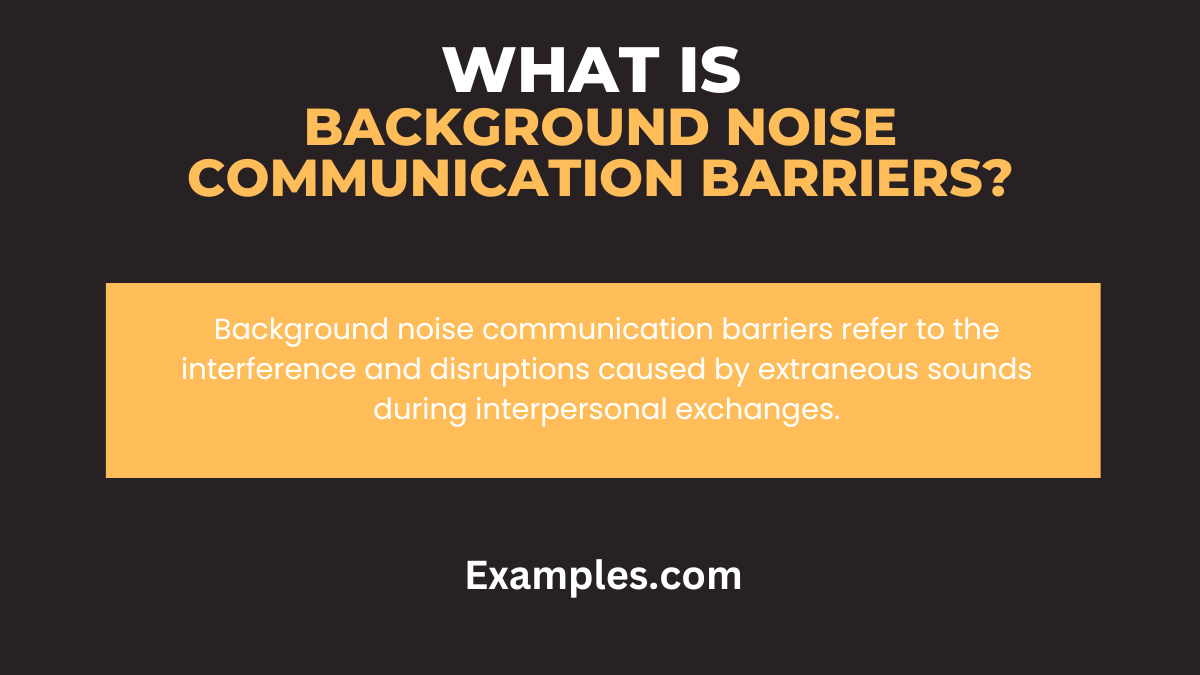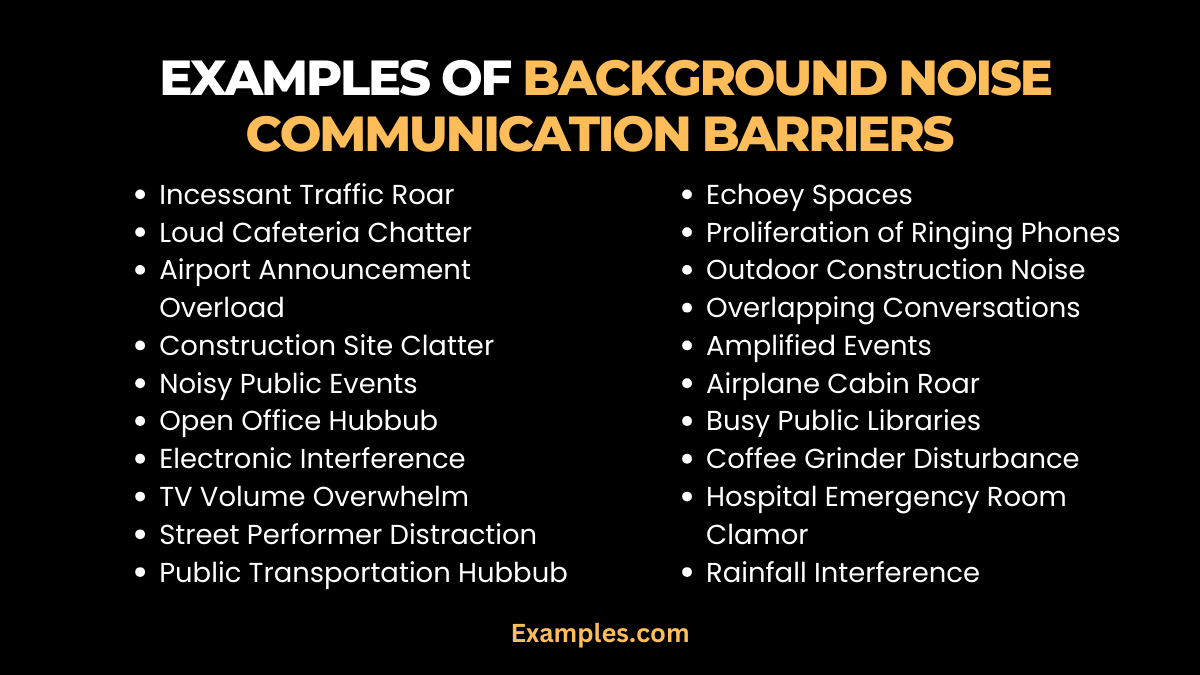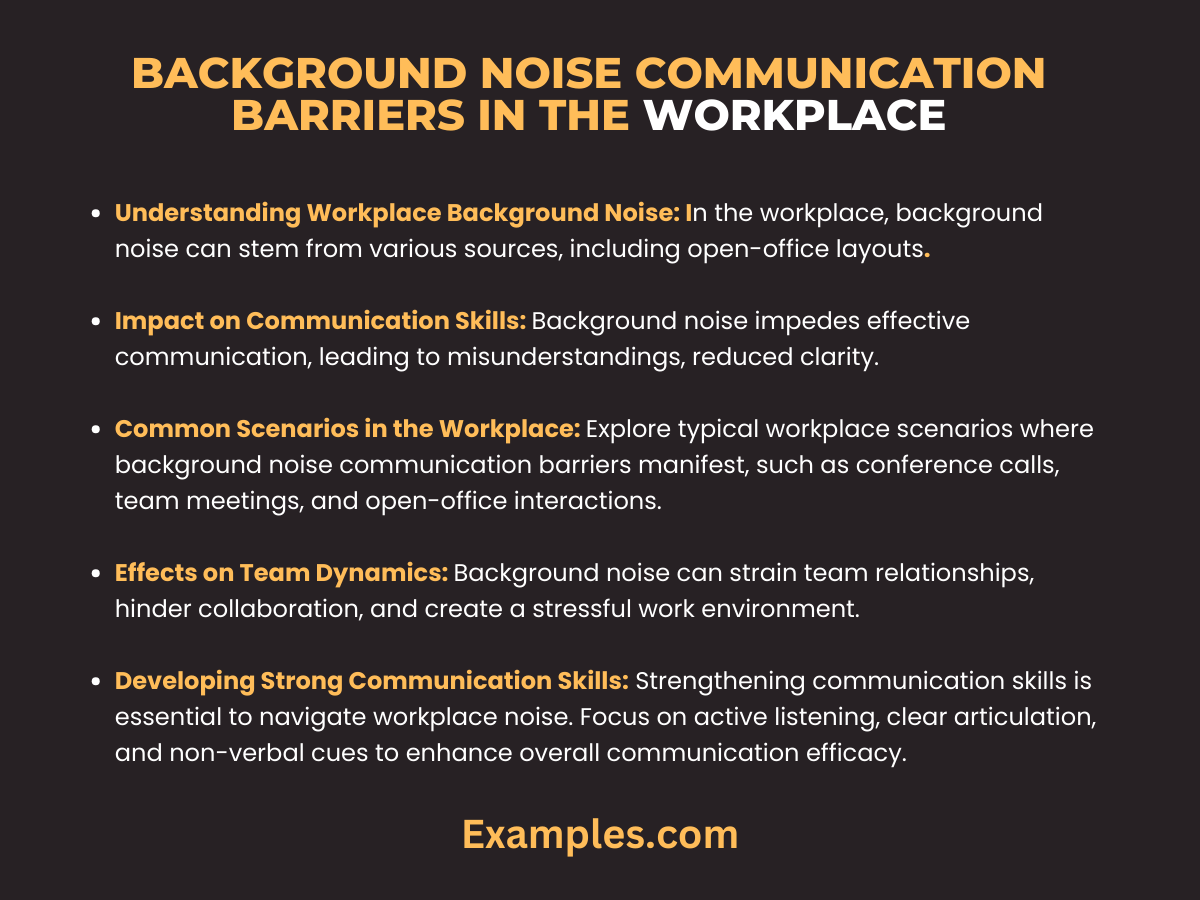19+ Background Noise Communication Barriers Examples
In the realm of communication, background noise stands as a formidable barrier, disrupting the clarity of messages and impeding understanding. Defined by the interference caused by extraneous sounds, this article delves into the intricacies of background noise communication barriers. Explore historical roots, discover illustrative examples, and unravel the origins of this hindrance. Gain valuable insights on how to navigate and overcome this pervasive challenge, accompanied by practical tips for fostering effective communication amidst the clamor of background noise.
What is Background Noise Communication Barriers?

Background noise communication barriers refer to the interference and disruptions caused by extraneous sounds during interpersonal exchanges. In simpler terms, it is the challenge of conveying and receiving messages amidst surrounding noises that can obscure or distort communication. These distractions can range from environmental sounds to electronic interference, creating hurdles in maintaining clear and effective dialogue. Understanding this definition is crucial in addressing and mitigating the impact of background noise on communication dynamics.
20 Examples of Background Noise Communication Barriers

Navigating communication amidst background noise poses significant challenges, leading to misunderstandings and disruptions. Explore these 20 vivid examples of background noise communication barriers, gaining insights into the diverse scenarios where clarity may be compromised.
- Incessant Traffic Roar: Attempting to converse on a busy street becomes arduous, with the constant vehicular hum drowning out speech.
- Loud Cafeteria Chatter: Ordering in a bustling cafe can be frustrating, as the cacophony makes it challenging to communicate preferences clearly.
- Airport Announcement Overload: Important information can be lost in the mix of overlapping announcements at a bustling airport.
- Construction Site Clatter: Coordinating tasks becomes difficult in a construction zone, where the noise hinders precise communication.
- Noisy Public Events: Shouting over the din at public gatherings often leads to miscommunication and missed details.
- Open Office Hubbub: In shared workspaces, background chatter can hinder focused communication and impede productivity.
- Electronic Interference: Buzzing phones or static on calls can disrupt virtual communication, causing information loss.
- TV Volume Overwhelm: An elevated television volume can drown out important conversations in a living room setting.
- Street Performer Distraction: Enjoying street performances while communicating nearby becomes challenging due to the ambient noise.
- Public Transportation Hubbub: Conversations on buses or trains can be marred by the constant hum of engines and passengers.
- Echoey Spaces: In areas with poor acoustics, echoes amplify background noise, complicating conversation.
- Proliferation of Ringing Phones: Multiple ringing phones in a confined space can create chaos, disrupting discussions.
- Outdoor Construction Noise: Al fresco meetings near construction sites are hindered by the persistent noise of machinery.
- Overlapping Conversations: Simultaneous discussions in close quarters create confusion, making it hard to focus on one conversation.
- Amplified Events: Stadiums or concert venues amplify background noise, challenging communication in crowds.
- Airplane Cabin Roar: Conversations during flights are hindered by the constant drone of engines and airflow.
- Busy Public Libraries: Even in quiet spaces, the rustling of papers and hushed conversations can disrupt focus.
- Coffee Grinder Disturbance: Ordering at a café with a loud coffee grinder can complicate communication between customers and baristas.
- Hospital Emergency Room Clamor: Vital information exchange in emergency rooms may be compromised by surrounding noise.
- Rainfall Interference: Communicating outdoors during rain becomes challenging due to the drumming sound, affecting clarity.
Background Noise Communication Barriers In The Classroom
In the dynamic setting of a classroom, background noise can significantly impede effective communication, hindering the learning experience for both educators and students. Understanding and addressing these communication barriers is crucial for fostering an optimal educational environment. Let’s delve into a comprehensive guide on identifying, mitigating, and enhancing communication skills amidst the specific challenges posed by background noise in the classroom.
Classroom Background Noise Communication Barriers
- Traffic Sounds Through Windows: Open windows may allow traffic noise to infiltrate the classroom, making it challenging for students to concentrate.
- Interference from Adjoining Rooms: Sounds from adjacent classrooms or hallways can disrupt ongoing discussions.
- HVAC System Hum: The constant hum of heating, ventilation, and air conditioning systems can create a persistent audio backdrop.
Origin and History of Classroom Communication Challenges
Understanding the historical context of classroom communication challenges helps educators appreciate the evolution of these barriers. From traditional chalk-and-board classrooms to modern multimedia setups, the sources of background noise have evolved, necessitating adaptive communication strategies.
How Classroom Design Impacts Communication Skills
The layout and design of a classroom play a pivotal role in either exacerbating or mitigating background noise communication barriers. From seating arrangements to acoustics, the physical space significantly influences the ease of communication.
Tips for Educators to Improve Communication Amidst Noise
Educators bear a critical responsibility in overcoming background noise communication barriers. Practical tips, such as incorporating technology, employing effective vocal projection, and fostering an interactive learning environment, can empower teachers to navigate these challenges successfully.
Empowering Students with Communication Skills in Noisy Environments
Equipping students with effective communication skills amidst background noise is essential for their academic success and future professional endeavors. Cultivating active listening, clear articulation, and non-verbal communication proficiency can empower students to overcome classroom noise barriers.
Utilizing Technology to Mitigate Classroom Noise
In the digital age, leveraging technology can be a game-changer in managing background noise communication barriers. From noise-canceling technologies to interactive online platforms, educators can harness innovative solutions to enhance communication effectiveness.
Collaborative Efforts for a Quieter Classroom Environment
Creating a conducive learning atmosphere requires collaboration among educators, students, and administrative staff. Establishing clear communication protocols, conducting regular noise assessments, and fostering a shared responsibility for maintaining a quiet environment contribute to the overall success of noise reduction efforts.
Background Noise Communication Barriers In The Workplace

In the bustling environment of a workplace, effective communication is paramount for productivity and collaboration. However, background noise can present substantial barriers. Here’s a comprehensive guide on understanding and overcoming background noise communication barriers in the workplace, enhancing your overall communication skills.
- Understanding Workplace Background Noise: In the workplace, background noise can stem from various sources, including open-office layouts, electronic devices, and communal areas. Identifying these sources is the first step in mitigating their impact.
- Impact on Communication Skills: Background noise impedes effective communication, leading to misunderstandings, reduced clarity, and lowered productivity. Recognizing the toll it takes on communication skills is crucial for addressing the issue.
- Common Scenarios in the Workplace: Explore typical workplace scenarios where background noise communication barriers manifest, such as conference calls, team meetings, and open-office interactions.
- Effects on Team Dynamics: Background noise can strain team relationships, hinder collaboration, and create a stressful work environment. Understanding these effects is crucial for fostering a positive team dynamic.
- Developing Strong Communication Skills: Strengthening communication skills is essential to navigate workplace noise. Focus on active listening, clear articulation, and non-verbal cues to enhance overall communication efficacy.
Background Noise Communication Barriers In Hospital
Hospitals, essential hubs of care, often contend with persistent background noise that poses formidable communication barriers. This guide illuminates the challenges and strategies to optimize communication amidst these hurdles.
- Understanding Hospital Noise Origins: Hospitals buzz with various sources of noise—medical equipment, paging systems, intercoms, and bustling foot traffic—that create a challenging soundscape for effective communication.
- Impact on Patient Care and Staff Coordination: Background noise impedes patient-staff communication, hindering the transmission of critical information and potentially impacting treatment accuracy and patient outcomes. Additionally, it complicates teamwork and coordination among healthcare providers.
- Examples of Communication Challenges: Instances include difficulty in hearing patient concerns, misinterpretation of instructions, and hindrances in conveying urgent messages amid the hospital’s ambient noise.
- Strategies to Mitigate Background Noise: Implementing sound-reducing measures such as quieter equipment, strategic layout planning, and designated quiet zones can help alleviate noise-related communication barriers.
- Utilizing Clear Communication Techniques: Healthcare professionals can employ clear enunciation, visual aids, and written instructions to ensure effective communication despite the surrounding noise.
- Technology-Based Solutions: Leveraging communication technologies like specialized headsets or devices that cancel or minimize background noise can significantly enhance intra-staff and patient-staff interactions.
What Are The 4 Types Of Background Noise Communication?
In the realm of communication skills, recognizing and mitigating the impact of background noise is essential for effective dialogue. This guide breaks down the 4 distinct types of background noise communication, offering valuable insights into how these barriers manifest and strategies to overcome them.
- Physical Background Noise: Physical noise emanates from the environment, including sounds such as traffic, construction, or machinery. Discover how to navigate communication in settings with prevalent physical background noise and strategies to minimize its impact on clarity.
- Electronic Interference: In an increasingly connected world, electronic devices contribute to communication challenges. Explore how buzzing phones, static on calls, or interference from electronic equipment can disrupt communication, and learn techniques to mitigate these electronic disturbances.
- Social Background Noise: Social settings often introduce background noise through conversations, laughter, or other interpersonal interactions. Delve into the nuances of communicating effectively amidst social background noise and understand how to adapt communication strategies in dynamic group environments.
- Psychological Background Noise: Psychological factors, such as stress, anxiety, or preoccupations, can act as internal barriers to communication. Uncover the intricacies of psychological background noise and explore techniques to manage and alleviate these mental distractions for improved interpersonal communication.
How To Manage Background Noise As An Employer?
In a bustling workplace, background noise can significantly impact communication, productivity, and employee well-being. As an employer, mastering the art of managing background noise is crucial for fostering a conducive work environment. Follow this comprehensive guide to enhance communication skills and create an atmosphere where your team can thrive amid potential auditory distractions.
- Understanding the Impact of Background Noise on Communication Skills: As an employer, recognizing how background noise affects communication is the first step. Understand the potential barriers it poses to effective workplace dialogue, collaboration, and overall productivity.
- Conducting Noise Audits in the Workplace: Initiate regular assessments of your workplace environment to identify prevalent sources of background noise. These audits can pinpoint areas that require intervention to optimize communication channels.
- Implementing Design Strategies for Noise Reduction: Employ effective workplace design strategies such as soundproofing, strategic placement of partitions, and the use of noise-absorbing materials to minimize the impact of background noise on communication.
- Introducing Dedicated Quiet Spaces: Establish designated quiet zones within the workspace where employees can retreat for focused work or confidential conversations, fostering clear and undisturbed communication.
- Leveraging Technology Solutions: Explore and invest in noise-canceling technologies and acoustic solutions that can effectively mitigate background noise, ensuring smoother communication during meetings, calls, and collaborative sessions.
- Flexible Work Arrangements: Consider incorporating flexible work arrangements, such as remote work options or adjustable work hours, allowing employees to choose environments conducive to effective communication.
- Providing Noise-Canceling Equipment: Supply employees with noise-canceling headphones or other relevant equipment to empower them in managing background noise, especially in open-office settings.
- Establishing Clear Communication Protocols: Define and communicate clear guidelines for communication within the workplace. This includes setting expectations regarding appropriate noise levels during different activities and fostering a culture of respect for others’ need for concentration.
- Training Programs for Effective Communication: Develop training programs that focus on enhancing communication skills in the face of background noise. Equip employees with strategies to articulate messages clearly and listen attentively, even in challenging acoustic environments.
- Encouraging Open Dialogue: Foster a culture where employees feel comfortable expressing their concerns about background noise. Establishing open channels for dialogue allows for collaborative problem-solving and ensures that communication remains a top priority.
In conclusion, mastering communication amidst background noise is essential for fostering clarity and understanding. The examples provided highlight the diverse challenges, while the comprehensive guide equips readers with practical strategies. By understanding, identifying, and implementing effective solutions, individuals can navigate the complexities of background noise communication barriers, ensuring seamless and meaningful interactions in various contexts.



